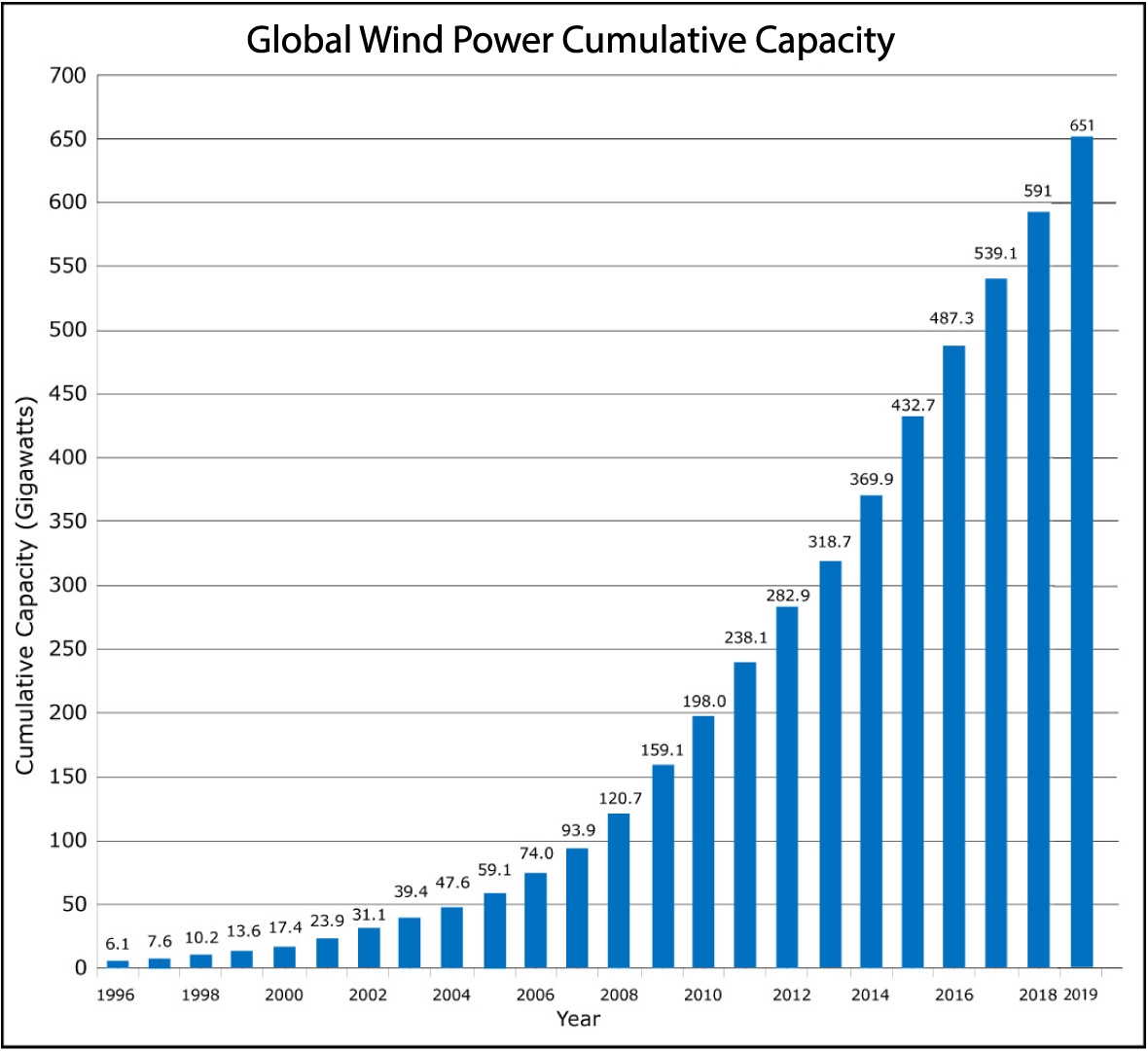Meeting a Wind Power Goal
This math activity is a little different in format from most others. You can work either individually, in pairs, or in small groups. Try to answer each question for yourselves first, then open the answers to see if you did them correctly.
1. The fact that wind is an intermittent source of energy means that average power generation of a wind turbine is less than its total capacity at full operation. For example, imagine a large wind turbine that, when operating fully, can generate 4 megawatts of power. If this turbine operates only 1/4 (25%) of the time, then its actual average power would be only 1 megawatt. The fraction of the time that a power source actually operates is called its capacity factor , so in this case the capacity factor for the turbine would be 25%. Use this idea to write a simple formula that tells you the average power of a wind turbine based on its total capacity (when fully operating) and its capacity factor.
The formula is:
Notice how this gives the correct answer for the example already discussed: For a turbine with total capacity of 4 megawatts, multiplying by the capacity factor of 25% gives its average power of 1 megawatt.
2. Use Figure 7.3.1–5 to find the global installed wind capacity for the year 2019. If we assume a global average capacity factor of 30% for wind, approximately what was the actual average power generated by wind that year?
The graph shows that installed global wind capacity for 2019 was 651 gigawatts. The 30 capacity factor means that the actual average power was 30% of that value, which means:
Actual capacity factors for wind power vary greatly from one location to another. The range for existing wind turbines is from about 15 to 60 ; the 30% used in this example is a reasonable global average.
3. Based on your answer to question 2, approximately what fraction of the world’s total average power usage of 15 terawatts came from wind in 2019? Hint: Note that 1 terawatt = 1,000 gigawatts.
In question 2, you found that wind supplied an average of about 195 gigawatts of power in 2019. Because 1 terawatt = 1,000 gigawatts, a world total power usage of 15 terawatts is the same as 15,000 gigawatts. Therefore, we simply divide to find the faction generated by wind power:
Now, remember that 0.01 is the same as 1, so 0.013 is the same as 1.3. In other words, if the wind capacity factor was
30, then wind power generated about 1.3% of the world’s energy in 2019.
4. Suppose we set a goal of generating 25% of the world’s energy through wind power. Based on your answer to question 3, approximately how much more wind capacity would the world need to meet this goal? Give your answer as a multiple of the total installed capacity in 2019.
Recall that current average global power usage is about 15 terawatts, so 25% of this is:
Because 1 terawatt = 1,000 gigawatts, this is the same as 3,750 gigawatts. From Question 3, actual average global power from wind in 2019 was 195 gigawatts. Therefore, the 25% wind production goal is larger than the 2019 average power from wind by a factor of:
To summarize, meeting the goal of obtaining 25; of global energy from wind would require about 19 times as much wind capacity as was installed in 2019. Since this includes the amount already installed (as of 2019), the world would need to add about 18 times as much new wind capacity. In other words, since the installed capacity was about 650 gigawatts in 2019, reaching the 25% goal would require installing an additional 18 × 650 gigawatts = 11,700 gigawatts of total capacity. Since we are being approximate, we’ll round this to 12,000 gigawatts, which is the same as 12 terawatts.
5. Figure 7.3.1–5 shows that total wind capacity increased by 60 gigawatts in the one year ending in 2019 (from 591 gigawatts in 2018 to 651 gigawatts in 2019). Suppose the world continues to add the same 60 gigawatts of wind capacity each year (starting from 2019). Based on your answer to question 4, how long would it take to meet the 25% goal?
In question 4 you found that the world would need to add about 12,000 gigawatts of total capacity. At an install rate of 60 gigawatts per year, this would require:
Given current concerns about global warming, it would not make sense to wait 200 years to build this capacity. Therefore, for wind to make a major (such as 25%) impact on our total energy needs, we would need to vastly increase the rate at which new wind turbines are built and installed.
6. Does the graph in Figure 7.3.1–5 give you any reason to think that we might reach the 25% goal much faster than you found in question 5? Explain.
Yes, because the graph shows an accelerating trend in the rate at which wind capacity is growing. If that acceleration continues (marking what we call exponential growth), then it might be possible to meet the 25% goal much sooner, perhaps even by 2050 — but only with a major, global effort to make it happen.
